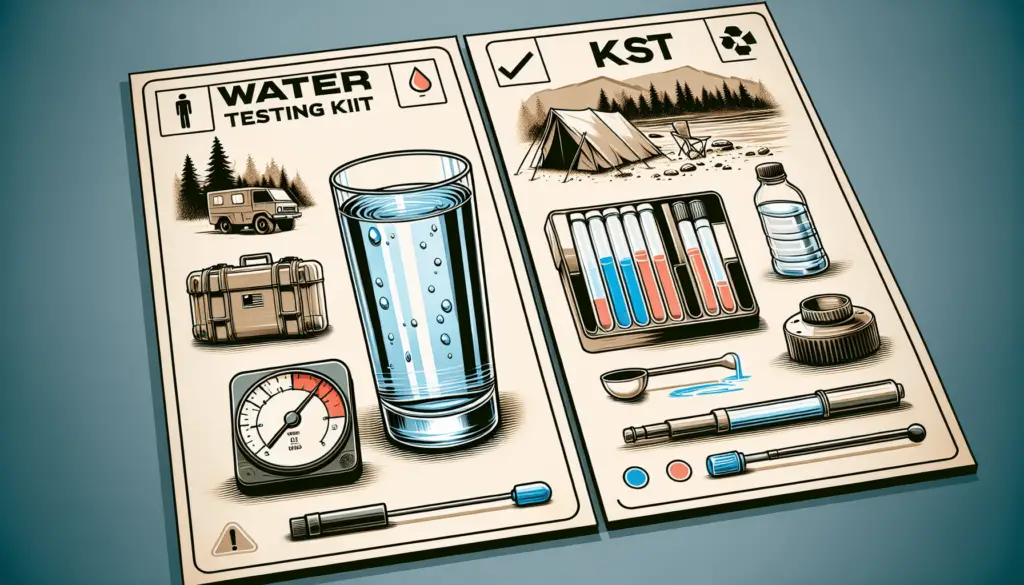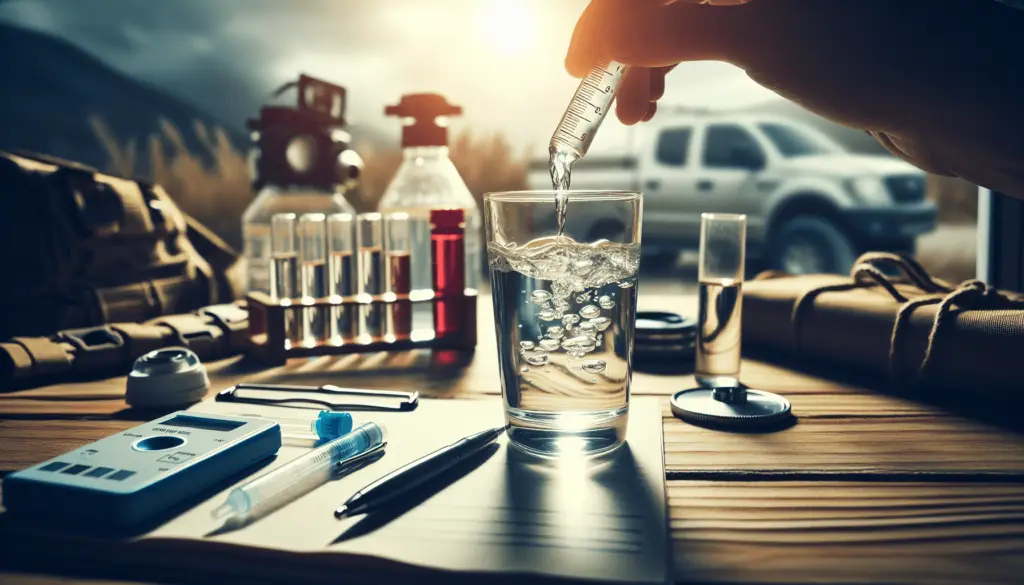Is it important to test the quality of your water before including it in your prepping supplies? Absolutely! In emergency situations or when preparing for disasters, having access to clean and safe water is crucial for survival. With the growing concern over water pollution and contamination, testing the quality of water before storing it for emergencies is a smart and necessary step. In this article, we will delve into the importance of water quality testing in prepping and provide you with valuable information on how to ensure the water you are storing is safe for consumption.

Why Water Quality Testing Is Important
Testing the quality of your water is essential to ensure its safety for consumption. Water sources can be contaminated with various pollutants, bacteria, and other harmful substances that are not visible to the naked eye. By conducting water quality tests, you can identify any potential contaminants in your water and take the necessary steps to treat or filter it before using it for drinking, cooking, or other purposes.
When you’re prepping for emergencies, you want to make sure that the water you have stored will be safe to drink when the time comes. Testing the quality of your water ahead of time will give you peace of mind and confidence in the safety of your stored water supply.
Conversational tone:
“Imagine being in a disaster scenario and finally finding a water source to quench your thirst, only to realize it’s contaminated. By testing the quality of your water in advance, you can avoid such a risky situation and be well-prepared for any emergency.”
Common Contaminants in Water
Water can contain a variety of contaminants that pose serious health risks if ingested. These contaminants can come from a range of sources, including industrial runoff, agricultural pesticides, sewage, and naturally occurring substances. Some common contaminants found in water include:
Microorganisms
Bacteria, viruses, and parasites are invisible to the naked eye but can cause serious illnesses if consumed. Contaminated water can lead to diseases such as cholera, dysentery, and giardiasis.
Chemicals
Chemicals such as lead, arsenic, pesticides, and industrial pollutants can leach into water sources and contaminate them. Long-term exposure to these chemicals can have detrimental effects on health, including organ damage and even cancer.
Heavy Metals
Heavy metals like mercury, cadmium, and nickel can contaminate water sources through industrial waste, mining activities, and natural deposits. Ingesting water contaminated with heavy metals can lead to serious health issues, including neurological disorders and kidney damage.
Conversational tone:
“Knowing the common contaminants found in water can help you understand the importance of testing its quality. By identifying these harmful substances, you can take the necessary steps to ensure your stored water is clean and safe for consumption.”
How to Test Water Quality
There are several methods available for testing the quality of your water, ranging from simple at-home test kits to more comprehensive laboratory analysis. The choice of method will depend on the level of accuracy required and the specific contaminants you are concerned about. Here are some common methods for testing water quality:
At-Home Test Kits
At-home test kits are convenient and easy to use, providing quick results for common contaminants such as bacteria, lead, chlorine, and pH levels. These test kits typically come with instructions on how to collect a water sample and perform the tests yourself.
Laboratory Testing
For more comprehensive analysis, you can send water samples to a certified laboratory for testing. Laboratory testing can detect a wider range of contaminants at lower detection limits, providing more accurate results. While this method may be more expensive and time-consuming, it is recommended for thorough water quality analysis.
Water Testing Strips
Water testing strips are affordable and easy to use, providing semi-quantitative results for various parameters such as chlorine, hardness, and pH levels. While not as accurate as laboratory testing, water testing strips can give you a general idea of the water quality and detect any significant issues.
Conversational tone:
“Whether you opt for at-home test kits, laboratory testing, or water testing strips, the important thing is to test your water regularly to ensure its safety. By incorporating water quality testing into your prepping routine, you can stay informed about the condition of your stored water and take proactive steps to address any concerns.”
Interpreting Water Quality Test Results
Once you have conducted a water quality test, it is important to interpret the results accurately to understand the condition of your water. The test results will provide information on various parameters, such as pH levels, chlorine content, and the presence of specific contaminants. Here are some key factors to consider when interpreting water quality test results:
Acceptable Levels
Compare the test results to established guidelines and standards for drinking water quality. Regulatory agencies such as the Environmental Protection Agency (EPA) provide guidelines on acceptable levels of contaminants in drinking water. If the test results exceed these standards, it may indicate a problem with the water quality.
Health Risks
Understand the potential health risks associated with the contaminants detected in your water. Research the health effects of specific contaminants and determine the appropriate measures to address any health concerns. Consulting with a water quality expert or healthcare professional can provide valuable insights into the health risks associated with your water supply.
Treatment Options
Based on the test results, identify the appropriate treatment options to improve the quality of your water. Common treatment methods include filtration systems, reverse osmosis, and UV disinfection. Select the treatment method that is most effective for removing the contaminants present in your water.
Conversational tone:
“Interpreting water quality test results may seem daunting at first, but with a little guidance, you can make sense of the data and take the necessary actions. Remember, the goal is to ensure that your stored water is safe and clean for consumption, so don’t hesitate to seek expert advice if needed.”

Importance of Regular Water Quality Testing
Regular water quality testing is essential to ensure the ongoing safety of your stored water supply. Water quality can change over time due to various factors such as environmental pollution, seasonal variations, and aging infrastructure. By testing your water regularly, you can monitor any changes in water quality and take prompt action to address any issues that may arise.
Seasonal Changes
Water quality can be affected by seasonal changes, such as heavy rainfall, snowmelt, and drought conditions. These changes can impact the source water quality and increase the risk of contamination. Testing your water before and after each season can help you identify any seasonal variations in water quality and adjust your storage and treatment methods accordingly.
Aging Infrastructure
Older homes and buildings may have aging plumbing systems that can introduce contaminants into the water supply. Lead pipes, corroded fittings, and outdated fixtures can leach harmful substances into the water, compromising its quality. Regular water quality testing can detect any issues with the plumbing system and guide you in making necessary repairs or upgrades.
Environmental Pollution
Pollution from industrial activities, agricultural runoff, and urban development can contaminate water sources and affect water quality. Testing your water for pollutants regularly can help you identify the presence of harmful substances and take steps to mitigate their impact on your water supply. By staying informed about potential sources of contamination, you can protect your stored water from pollution.
Conversational tone:
“Think of regular water quality testing as a way to stay ahead of potential issues and ensure the long-term safety of your stored water supply. By incorporating testing into your routine, you can stay informed about changes in water quality and take proactive steps to protect your health.”
Importance of Proper Water Storage
In addition to testing the quality of your water, proper storage is essential to maintain the safety and freshness of your water supply. How you store your water can impact its quality, taste, and shelf life. Here are some important factors to consider when storing water for emergencies:
Container Selection
Choose containers that are specifically designed for storing water, such as food-grade plastic containers, glass bottles, or stainless steel tanks. Avoid using containers that may leach harmful chemicals into the water, such as old milk jugs or detergent bottles. Make sure the containers are clean, sanitized, and tightly sealed to prevent contamination.
Location
Store your water in a cool, dark place away from direct sunlight and heat sources. Exposure to sunlight and heat can promote the growth of algae and bacteria in the water, compromising its quality. A basement, pantry, or closet is an ideal location for storing water long-term.
Rotation
Regularly rotate your stored water supply to ensure freshness and quality. Water that has been stored for an extended period may develop a flat taste or odors due to the absorption of plastic or the growth of microorganisms. By rotating your water supply every 6-12 months, you can maintain the quality and palatability of your stored water.
Protection
Protect your stored water from contamination by keeping it sealed and away from potential sources of pollution. Store water containers off the floor on shelves or raised platforms to prevent contact with dust, insects, or rodents. Use a cover or cap to seal the containers tightly and prevent the entry of contaminants.
Conversational tone:
“Proper water storage is just as important as water quality testing when it comes to prepping for emergencies. By following these simple guidelines for storing water, you can ensure that your water remains safe, clean, and refreshing when you need it most.”
Conclusion
In conclusion, water quality testing is a critical aspect of prepping for emergencies and ensuring the safety of your water supply. By testing the quality of your water, you can identify potential contaminants, health risks, and treatment options to protect your health and well-being. Regular testing, proper interpretation of results, and appropriate storage methods are essential for maintaining a clean and safe water supply for emergencies. Remember, clean water is a fundamental necessity for survival, so make sure to prioritize water quality testing in your prepping efforts.
Conversational tone:
“By taking the time to test the quality of your water and implement proper storage practices, you can rest assured that you are well-prepared for any emergency that comes your way. Stay informed, stay proactive, and stay safe with clean, safe water as your ally in times of need.”
In a world where water quality is constantly at risk and emergencies can strike at any time, being prepared with clean, safe water is a valuable asset that can make all the difference in your survival and well-being. Start testing your water quality today and take the necessary steps to ensure your stored water is of the highest quality for when you need it most. Your health and safety are worth the effort.
